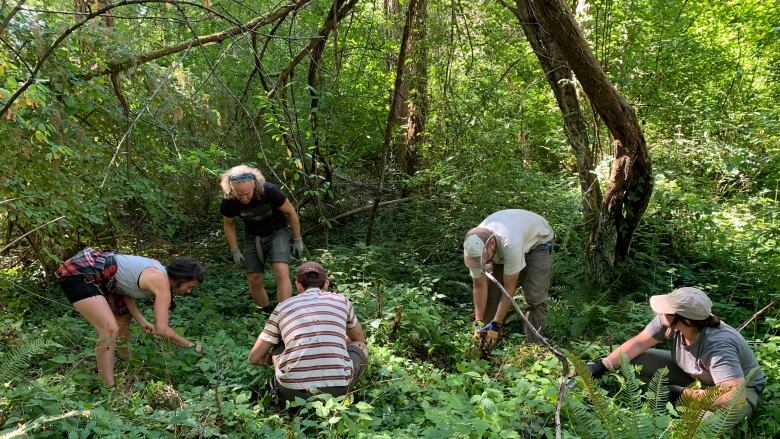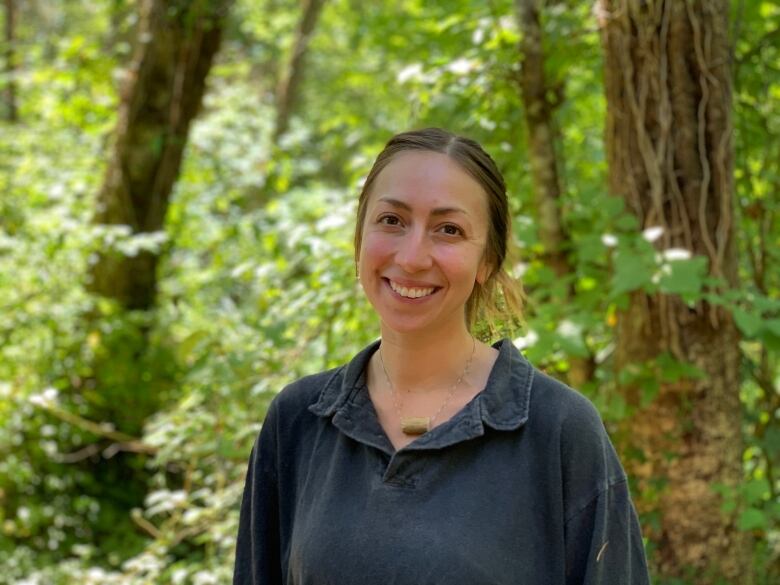Artist invites volunteers to pull invasive plants from Vancouver Island forest as an act of decolonization
Since the project started, Sarah Jim and her family say they have seen traditional plants, animals return

Once a month, a few dozen people gather in a backyard on a small First Nation on southern Vancouver Island to remove ivy and in doing so, they help decolonize the land, the founder of the volunteering event says.
The WSEM Ivy Project is the brainchild Sarah Jim and it happens on her family's land, which is some of the only remaining forest on the Tsyecum First Nation.
The forest, on the Saanich peninsula just north of Victoria, is overrun with invasive English ivy which chokes out native species.
But since the project started two years ago, Jim and her family have seen traditional plants, and animals, return.

Trillium can be seen poking through dirt, trailing blackberry spreads across the ground, and baldhip roses flourish.
While they're hard to spot, pacific chorus frogs (called WEXES in the SENOEN language) chirp in the background, and owls sit in the trees, overseeing everything.

"I feel like the land has been shown love, and it's like once you give something love, it gives you love back," Jim said.
She calls it physically decolonizing the land: in allowing native plants to flourish, it brings back food and medicine that her people had lost access to.

Jim is an artist who has also been working in ecosystem restoration for the past five years.
She had been slowly trying to pull ivy out of the forest herself, but the amount of work it required overwhelmed her.
After seeing success with volunteers in her day job in ecological restoration, she decided to try asking people to come help on her land and it worked.
In addition to slowly removing the ivy, she has watched a community arise, she says.
On volunteer days, people of all ages and backgrounds can be found crouched on the ground, ripping out ivy and chatting amongst themselves.
"Decolonization is part of the reason I'm here," said volunteer Judy Nault, "but also just to be in the forest and work with other people."
Kikila Perrin has been attending the event for over a year and a half. He works for Habitat Aquisition Trust (HAT), an organization that works to preserve land on southern Vancouver Island. It helps co-ordinate the monthly event with Sarah Jim.
Perrin attends as a volunteer, but it also aligns with his research.
A PhD student at the University of Victoria, he's researching place-based relationships, and how settlers can support Indigenous people in meaningful ways.
He's noticed that the work in the forest can make it easier for non-Indigenous people to listen, and be open to Indigenous perspectives.

He thinks it's a great way for anyone to get involved in reconciliation and find a community.
"You don't need to be an expert. You don't need to even know anyone. But I guarantee by the end of the day, you'll know about one species and you'll know a bunch of people who will maybe keep you coming back."
Sarah Jim agrees. She'd like to see the volunteers at her events encourage friends and family to take part in restoration in their communities.
"My hope is that this creates a ripple effect, and the land gets the attention it needs."
Once her family's land is cleared of invasive plants, she hopes to turn it into a community hub for members of her nation.













_(720p).jpg)


 OFFICIAL HD MUSIC VIDEO.jpg)
.jpg)



























































































